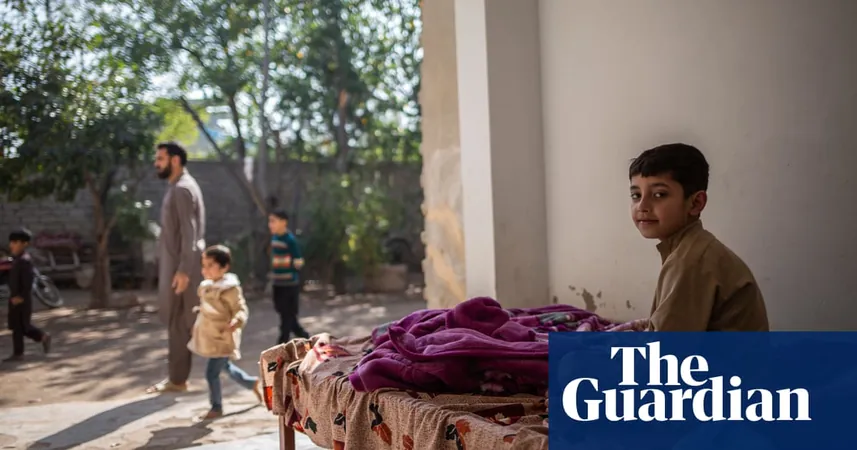
Urgent Crisis: The Rise of Drug-Resistant Typhoid in Pakistan - Are We on the Brink of a Health Catastrophe?
2024-09-24
Author: Arjun
Introduction
In the heart of Peshawar, Pakistan, a grave health warning is unfolding as children fall victim to a pervasive outbreak of drug-resistant typhoid. Among them, eight-year-old Ukasha and his friend, twelve-year-old AbuZar, have been battling severe cases of this illness for weeks—longer than typical recoveries for a disease that once responded quickly to antibiotics.
Understanding Typhoid Fever
Typhoid fever, an infection caused by the bacteria Salmonella typhi, is contracted through contaminated food or water. When untreated, it carries a mortality rate of 20%. However, the fundamental issue lies in the shifting landscape of treatment; antibiotics that were once effective are failing to combat an alarming strain known as extensively drug-resistant (XDR) typhoid.
The Situation in Pakistan
In Pakistan, the situation is dire. The nation has reported over 15,000 cases of XDR-typhoid, with many outbreaks going unrecorded. Experts attribute this rise to a confluence of factors, including inadequate access to clean water and poor sanitation. Currently, Pakistan ranks among the lowest globally in providing safe drinking water, with contaminated supplies believed to cause around 80% of the country's diseases.
Expert Opinions
Dr. Maria Neira from the World Health Organization emphasizes the preventability of typhoid. "There is no reason we should have typhoid fever today if we have proper access to safe water and sanitation," she states. The underlying issue of contaminated water sources, particularly in educational institutions, further compounds the problem. Ukasha's father speculated that a tainted water tank at their school triggered the outbreak, despite officials denying any reported issues.
Vaccination Efforts
While the Pakistani government has initiated a vaccination campaign that has reached over 30 million children since 2019, the efforts have been concentrated in southern regions, leaving northern areas susceptible to this ongoing threat. The infection is indiscriminate, and as the outbreak spreads, millions of children remain unvaccinated.
Treatment Challenges
Medical professionals are struggling to treat these advanced cases; Ukasha’s infection required a last-resort antibiotic, meropenem, after traditional treatments failed. His treatment involved 22 painful injections, placing a heavy financial burden on his family.
The Urgency of Addressing Drug Resistance
The surge in drug-resistant infections is alarming, correlating with the overuse of antibiotics—especially where rapid test solutions fall short. Experts warn that the misuse of antibiotics in misdiagnosed cases has led to the proliferation of superbugs, leading to a situation where common treatments could soon be ineffective.
Global Health Discussions
The urgency of addressing drug resistance is now at the forefront of global health discussions, as world leaders prepare to meet at the UN to negotiate a political declaration on fighting drug-resistant infections. As medical experts warn, XDR-typhoid may serve as a harbinger of more formidable health challenges to come.
Conclusion
As Ukasha and AbuZar return to school, their struggle is far from over. Days after their treatments, both boys found themselves battling fevers once again, raising fears that this public health crisis is still very much alive. We must act now, or risk plunging back into an era where typhoid is a much deadlier foe, leaving vulnerable communities in its wake. The future of public health hangs in the balance as Pakistan confronts this urgent crisis.




 Brasil (PT)
Brasil (PT)
 Canada (EN)
Canada (EN)
 Chile (ES)
Chile (ES)
 España (ES)
España (ES)
 France (FR)
France (FR)
 Hong Kong (EN)
Hong Kong (EN)
 Italia (IT)
Italia (IT)
 日本 (JA)
日本 (JA)
 Magyarország (HU)
Magyarország (HU)
 Norge (NO)
Norge (NO)
 Polska (PL)
Polska (PL)
 Schweiz (DE)
Schweiz (DE)
 Singapore (EN)
Singapore (EN)
 Sverige (SV)
Sverige (SV)
 Suomi (FI)
Suomi (FI)
 Türkiye (TR)
Türkiye (TR)